#jeprog
Explore tagged Tumblr posts
Text
"Expanding Google Arts and Culture with Expeditions"
When I first joined Google 13 years ago, I was most excited by the company's sense of exploration and possibility. Search allowed you to look up nearly any fact in the world and Maps helped you find even the most remote destination. That spirit of possibility also led to the launch of Google Expeditions, a virtual reality (VR) tool designed to bring the world into every classroom. With this product, educators took students on new adventures to experience far-away places, travel back in time or learn about cultures unlike their own. It has been truly magical to see how educators and students alike incorporated our VR tours into their imaginative curriculums.
Engaging students in the classroom has taken on an entirely different meaning this year. As schools around the world reimagine education from the ground up for a hybrid world, we’ve also been thinking deeply about how to adjust our tools to meet the moment and simultaneously build for the future. We’ve heard and recognize that immersive experiences with VR headsets are not always accessible to all learners and even more so this year, as the transition to hybrid learning has presented challenges for schools to effectively use Expeditions.
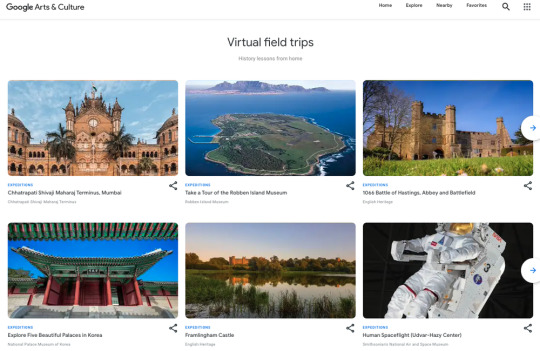
Virtual field trips on Google Arts & Culture
Many schools and families use Google Arts & Culture, Google’s free initiative to bring the world’s art and culture online, to experience museums, heritage sites and wonders of the world from their classrooms and homes. To continue to add to the collection, and make Expeditions 360 tours available to everyone, we're migrating most of them to Google Arts & Culture, accessible from the free site as well as the app on iOS or Android, where users can view the tours in 360 or on the web from any device. As Arts & Culture will offer many of the Expeditions tours, we'll no longer support the Expeditions app, and the app will no longer be available to download after June 30, 2021.
With the transition to the Google Arts & Culture platform, educators and students will find a vast array of culturally enriching content from around the world with collections on Natural History, Black History and Culture, the road to equality for women’s rights, and other topics like invention and discovery or fashion. Google Arts & Culture is continuing to expand its augmented reality (AR) content using interactive camera features, such as Art Filter and Art Transfer, that help you learn about cultural artifacts in new and engaging ways that would otherwise not be possible to create in the physical world.
We hope this product evolution to Google Arts & Culture will provide educators with a bridge to continue to use immersive content to transform their classrooms and enrich the learning experience for their students. As always, we’ll continue to share updates, user tips and gather feedback, and we look forward to continuing our support for the educational journeys of people around the world.
Source : The Official Google Blog via Source information
0 notes
Text
"How two Web Creators are celebrating Diwali"
For Web Creators, holidays can be a great way to connect with readers, providing tips and advice on how to prep for upcoming celebrations. Diwali, also known as the Festival of Lights, marks the beginning of the new Hindu year and is celebrated by spending time with friends and family, eating delicious foods, decorating with colorful designs and lighting diyas (oil lamps), which represent goodness and purity.
This year we sat down with two popular Web Creators, Hetal Vasavada (founder of Milk & Cardamom) and Neha Mathur (founder of Whisk Affair) to discuss how they approach the holidays from a content perspective and their must-have Diwali snacks.


How does a big holiday affect the way that you create content online?
Hetal: I’ve always shared all my recipes on my blog and the one thing bloggers know is that we do a lot of work for free. This year is actually the first time that I’ve ever done an Ebook. Investing in creating an Ebook of 10-15 recipes helps to offset all of the free content that is shared on my blog. Also if you look at the insights area of Pinterest or any other social media platforms, it’ll tell you when people start searching for things. It’ll let you know when people search for Halloween sweets or Thanksgiving meals. Make sure that you start posting around that time too!

Neha: I use Google Trends, Search Console and Google Analytics. From Google Trends I get to know what people are actually looking for and can then work to create a post around that. Google Search Console tells me the in and outs about which posts did well and which season they did well in. Once you start to do it, you’ll automatically start to get the hang of it.
Have you explored any new content formats on your blog?
Neha: Well, Web Stories just came out and I’m totally hooked on the short-story format! I’m trying to create a Web Story every single day and they are getting very good responses from readers.

What about Web Stories excites you to create content?
Neha:One thing I’ve noticed is that not everybody is enthusiastic about reading long articles. The best thing about Web Stories is that they see the snippets and if they like it they will move to your blog and check out your entire process. Let’s take Diwali for example: If I post a step-by-step recipe for Gulab Jamun, sometimes readers don’t have an idea of how easy or difficult the process can be. But after seeing a simplified version of that same recipe on Web Stories, they might be more likely to want to learn more and will go to your blog for the whole tutorial.
What is an unexpected dish that folks have for Diwali?
Hetal: Mexican bhel puri! Lately everyone is more into Indian fusion meals to make both the adults and the younger kids happy. So I’ll do Mexican Bhel puri where it’s tortilla chips, salsa—salsa is the chutney, tomatoes and guacamole. It’s almost like a mixed Mexican salad.
Neha: I would ask them to actually do a little fusion, so let’s say you love a boondi ka laddu. I have a fabulous recipe where I do a parfait kind of thing where I put a layer of rabri in a small parfait glass and then top with the boondi ka ladoo and it becomes a nice fusion dessert. It hardly takes any time so if you aren’t keen on making boondi ka ladoo or rabri at home you can always buy and then just assemble and make it your own dessert.
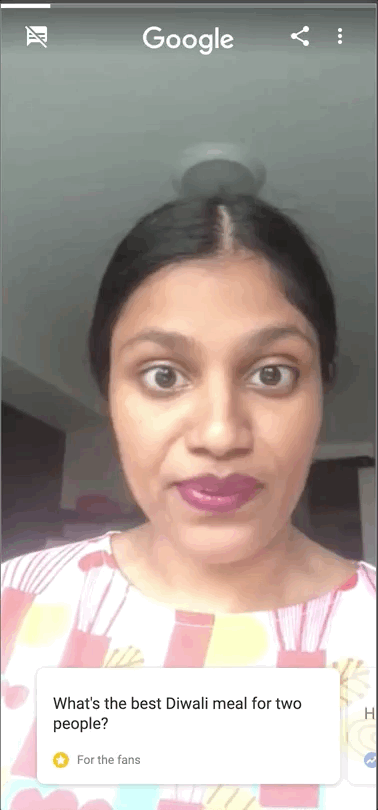
Can you give us a tip to make samosas at home?
Hetal: There are two types of people in the world, people who like the filling and people who like the crust. For me, the crust needs to be on point! One technique is double frying, you can fry it at a lower temperature around 350 F until they get golden and then turn the heat up to around 375 F and fry them again. That will help create those little bubbles on the outside of the pastry crust and it’s just so good, it really emphasizes the flakiness.
Source : The Official Google Blog via Source information
0 notes
Text
"Tenor, text sets, captions come to Web Stories for WordPress"
If you’re already using Web Stories for WordPress, we have a sweet new update for you—and if you’re not, now is the time to get started.
Web Stories for WordPress 1.1 is the first major update after the initial stable release and includes three big updates: Great typography at your fingertips with the help of the new font-aware text sets, countless high performance GIFs powered by Tenor and caption support for videos.

On the text tab, you’ll now find a list of high quality text sets created specifically for editorial use-cases. We partnered with the typography experts at iA, known for its award-winning app iA Writer and world-class typography craftsmanship. The result is a set of carefully created combinations that let you mix and match different harmonious typography, and a dynamic toggle (“Fonts in Use”) that shows you only text sets that match what you’re already using, so you can be confident that your choices pair well together.
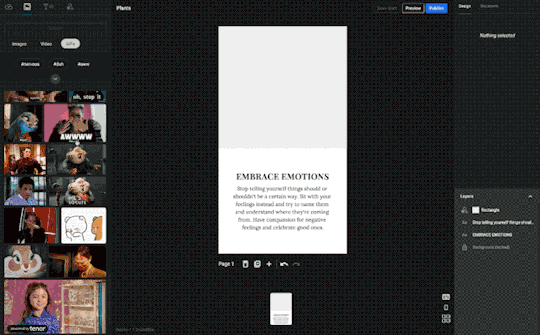
While Web Stories are a natural way to tell editorial stories, that doesn't mean they can't include fun visuals. Go wild and embed the perfect animated GIF into your story, just one click away courtesy of Tenor. And as an added bonus, we use high performance video instead of the GIF format behind the scenes to make sure stories load quickly.
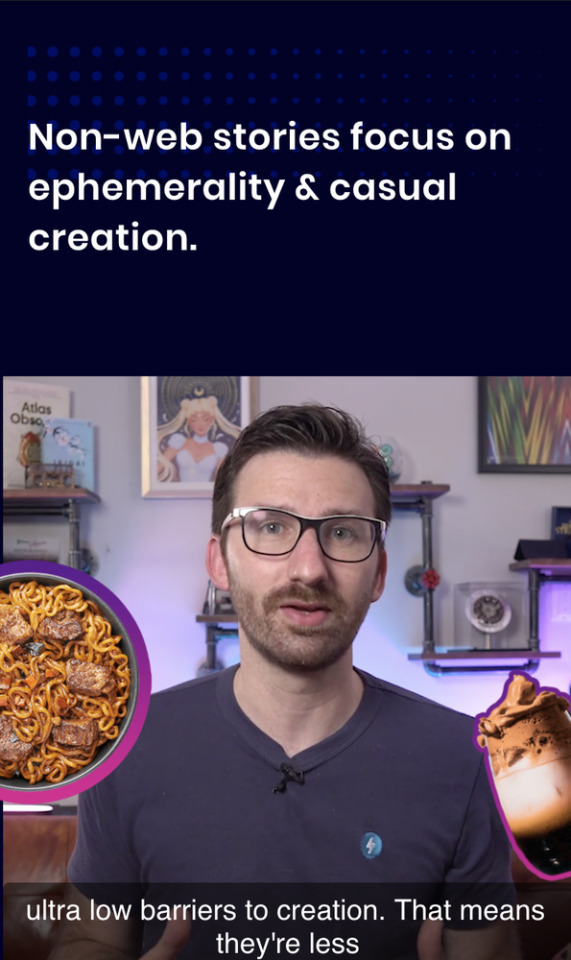
Video captions make your video more accessible.
Finally, watching Web Stories is getting a little easier for those who have hearing loss, or are simply in a situation where they can't turn up their volume. You can now upload video captions directly in the editor, making things easier to reach audiences who require text. Learn about the required VTT format and start adding them to all your videos today.
If you’ve made a cool story with the editor, tell us about it on Twitter or Instagram. And if you’re experiencing any bugs, let us know in our Support forum. We can’t wait to see what you make next.
Source : The Official Google Blog via Source information
0 notes
Text
"Bickey Russell finds inspiration from his native Bangladesh"
Welcome to the latest edition of “My Path to Google,” where we talk to Googlers, interns and alumni about how they got to Google, what their roles are like and even some tips on how to prepare for interviews.
Having spent his childhood between London, Milan and Dhaka, Bangladesh, Bickey Russell began his career at Google in sales before pursuing his passion for developing technology to serve under-resourced communities. Today, he’s the founder and leader of Kormo Jobs. Guided by Google's commitment to our AI Principles, Bickey and his team are helping job seekers across Bangladesh, Indonesia, and India find meaningful work.
What’s your role at Google?
I founded the Kormo Jobs app and currently lead global product operations for it as well as some other new projects in the Next Billion Users initiative at Google.
I drive Kormo Jobs’ go-to-market approach. This involves things like working with employers to use Kormo Jobs to post openings on our platform and building up a community of job seekers who get value from Kormo Jobs as they look for work and grow their careers.

Participants at a vocational training institute in Jakarta learning about Kormo Jobs.
You’ve held a few different roles in multiple offices. How did you end up working on Kormo Jobs?
I’m super passionate about the positive impact technology can have on society in countries like my native Bangladesh. Throughout my career at Google I have moved from business analysis to sales, partnerships management and leadership roles, and worked in London, Mountain View and currently, Singapore. Despite all that change, I have always been involved with initiatives to make Google products work better in Bangladesh—ranging from Maps to Bangla language capabilities.
In 2016, I was fortunate to be able to collaborate with colleagues and pitch an app idea I had to Google’s internal innovation incubator, Area 120. We were hoping to use machine learning to build a better way to help people in Bangladesh get jobs in more blue-collar sectors. Our small team was fortunate to join the Area 120 program, and after just three years, our app became a Google product. Kormo Jobs is live in Bangladesh, India and Indonesia.
And what were you up to before joining Google?
I grew up in London, Milan and Dhaka, spending middle school and high school in Dhaka before returning to London for university where I did a degree in geography.
I worked in retail throughout my time in university. The highlight was probably selling band t-shirts in Camden Market! My first full-time job was working as a researcher, and then as a business analyst.
Can you tell us about your decision to apply to Google?
I was fascinated by the Internet, and I wanted to join a fast-paced company that has an entrepreneurial and open working culture. Google’s vision was majorly inspiring and so attractive to me at the time, and it still is. I felt that if I could join a company like that, I could make an impact.
I applied via the Google careers page. The interview day was quite nerve-wracking, but actually a lot of fun. I remember talking a lot about my interest in cricket, plus my favorite websites and Google products. I was also asked to propose a plan on how we might develop the market for Google AdWords in the UK for a particular industry. That was a challenge, but I guess I did okay!
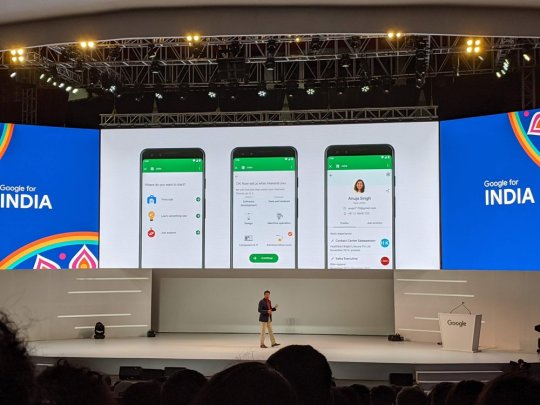
Bickey presenting the Kormo Jobs app at a Google India event.
Can you tell us about the resources you used to prepare for your interview or role?
I didn’t know anyone who worked at Google at the time, but since I knew the job was to join the advertising business in the UK, I reached out and talked to a lot of my network in the advertising and media space to prepare. Plus, I used Search to do research!
Do you have any tips you’d like to share with aspiring Googlers?
I would say that aspiring Googlers should really think about why they are interested in the specific role they are applying for. I often interview candidates who are keen to work at Google but haven’t done enough preparation on why they would be a good fit for the role and team that they have applied to join.

Bickey working with an employer using Kormo Jobs.
What inspires you to log in every day?
Having been at the company a long time, I’ve seen firsthand countless times the impact technology can have on people and society at large.
I am inspired by the fact that Google’s AI Principles guide us to make socially beneficial AI systems—and that I get to work with an amazing team at Kormo Jobs to put this principle into practice every day. We invest in applying our tech capability to solving important problems—finding work, earning money, building a career—to people in places like my home town of Dhaka.
Every day I get excited when I see that we’ve helped more people get a job than we did the day before.
Source : The Official Google Blog via Source information
0 notes
Text
"A sign language app to bridge the hearing gap"
My partners and I started DeafTawk, a mobile application that provides online sign language interpretation at an affordable cost, to eradicate hurdles in communication for the deaf community. I was born blind, like my co-founder AQ, while our other-co-founder, Wamiq, is hearing impaired. Growing up in Pakistan, each of us was well aware that there are too many barriers for people with disabilities to be successful.
Our tagline for DeafTawk is “Bridge the Gap.” We thought, wouldn’t it be incredible if we could connect deaf people all over the world with quick and easy sign language interpretation, from their phones? We started in 2018 with two interpreters and no customers. Today, we have more than 1,100 interpreters and we’ve helped nearly 18,000 people in Singapore and Pakistan. But we wanted to do more. As we looked to the next stage for DeafTawk, we knew that we still had our own gaps that we wanted to bridge.

We were thrilled to learn that we’d been selected for the Google for Startups Accelerator, a three-month online program to support startups working on social, economic and health problems across the region. We saw it as an opportunity to expand our knowledge and expertise in AI and machine learning, and explore how we could widen our customer base among businesses.
In the last few months, we’ve attended workshops and worked with different Google mentors to help us refine our business strategy, engage investors in a more targeted manner and ensure they are the right match. Our mentors challenged us to see things from a different perspective, while serving as a constant support whenever we faced challenges. We were given networking opportunities, allowing our team to come into contact with experts in the tech community. And the AI team at Google has been working with us to develop a prototype for our sign language interpretation solution, which would provide the option to use a bot that can automatically sign based on text or voice inputs. We’re hoping to launch this soon. Looking ahead, our goal is to expand to even more markets and reach 250,000 users by the end of 2024.
Today marked the official completion of the GfS Accelerator program. Along with our fellow graduates—Advance, GIZTIX, Hacktiv8, Kata.ai, MHub, Riliv, Rumarocket, Sehat Kahani, SenzeHub, Shoplinks, Smartfuture, Thuocsi.vn, TopCV and Walee—we’re grateful for the the chance to take our business to the next level and help find solutions to pressing challenges across our region.
Source : The Official Google Blog via Source information
0 notes
Text
"Dive into Diwali at home with Google Arts & Culture"
Every autumn, millions of people around the world come together for firework displays, feasts, prayer, and festivities in celebration of Diwali—the festival of lights. Millions of clay lamps illuminate homes and public spaces. Floors are covered with cheerful rangolis to bring good luck. With the food, family and festivities, Diwali is all about the experience of coming together, and the vibrant spectacle of color and light, but the global pandemic changes how we celebrate this year. Google Arts & Culture has created a virtual Diwali experience that everyone can be a part of, wherever you are in the world.
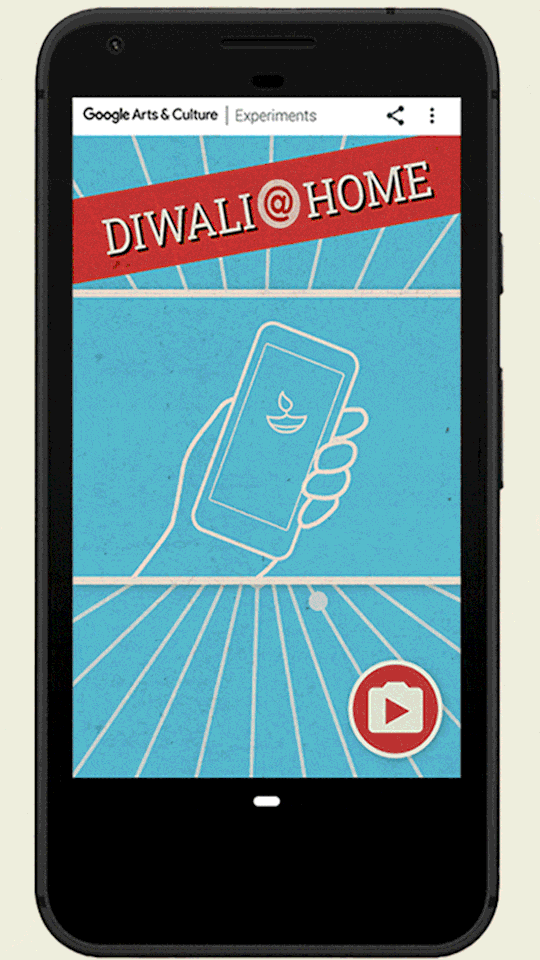
Festive lights in Augmented Reality
To recreate some festival fervor, try out a new Augmented Reality experience. Decorate your space virtually with diyas (lamps), detonate virtual anar (firecrackers), for some explosive, playful fun, and to learn more about these important cultural traditions.

10:25
Dive into Diwali from home
Google Arts & Culture has partnered with over 20 cultural heritage organisations to launch Diwali @ Home. Striking images and immersive online stories weave a journey through the festival of lights, its legends and folklore, and dive into the sights, sounds and smells of an iconic festival.
Month of Kartika.jpeg
Month of Kartika from the collection of Chhatrapati Shivaji Maharaj Vastu Sangrahalaya
Dokra Diya.jpeg
Dokra Diya from the collection of Banglanatak
Radha Krishma Fireworks.jpeg
Radha and Krishna Watching Fireworks in the Sky from the collection of National Museum, New Delhi
The color, food, festivities and nostalgia of Diwali are shared through new online exhibitions from partner institutions including Chhatrapati Shivaji Maharaj Vastu Sangrahalaya, Indian Museum, National Museum and many more.
Interactive art coloring book for family fun
There’s also plenty of hands-on fun for families with interactive coloring books—in artworks inspired by traditional Indian paintings in a specially developed coloring book! Find it with Google Search, simply by searching for “Diwali” on your phone.

Lady Lighting a Lamp from the collection of Salar Jung Museum, and a page from the interactive Diwali art coloring book
Finally, watch a video conversation between Amish Tripathi, author and Director of The Nehru Centre, and art historian broadcaster and former museum director Neil MacGregor on Diwali and why it’s particularly special this year.
So, with the help of a little Google magic, we hope our Diwali @ Home experience adds to your festive cheer as you celebrate in your own way this year, on the Google Arts & Culture app foriOS andAndroid.
Source : The Official Google Blog via Source information
0 notes
Text
"What veterans can bring to the business world"
2019 Google for Startups networking event for Veterans and Military Spouses at the American Underground in Durham, NC. Photo by Erin Bell of Bull City Photography.
For veterans, the transition from military life to the workforce can be tricky. I know how crucial it is to offer support, because I’ve been there myself. It's not that I doubted my abilities, but after eight years as a Navy officer, I quite literally did not know what my options were in the professional world.

Kevin Ryan
Thankfully, I was fortunate to land in a challenging role with a ton of support at Google. Even still, I remember feeling completely overwhelmed during my first two weeks before realizing when I had felt just as lost before: My first time on a submarine. When I first struggled to get my bearings on a ship, I taught myself to focus on the task at hand and get the job done.
Similarly, when I first started out in tech I didn’t necessarily know what program management or technical operations entailed, but I did know how to take absolute ownership over a specific assignment. These skills might have different names in the military and civilian worlds, but they do translate—and American businesses can benefit from this kind of tactical experience.
Veterans are uniquely qualified to tackle the challenges of building a company. We have the ability to handle uncertainty, face challenges with grit and perseverance, work collaboratively in a mission-focused and results-oriented manner, communicate clearly and lead effectively—all key attributes for aspiring entrepreneurs. I’ve seen this firsthand not only in my current role as Network Deployment Manager at Google Fiber, but as a VetNet mentor at Atlas.
Based down the street from me in Durham at Google for Startups tech hub American Underground, Atlas helps guide the military community in life beyond the uniform through opportunities in education, employment training and entrepreneurship. I’ve loved bringing Google resources to help Atlas attract talent and assist transitioning service members with resumes and job-seeking advice.
And we want to discover what more we can do to help veterans pursue entrepreneurship. Google for Startups recently teamed up with Endeavor Research to learn more about the current state of veteran entrepreneurship in the United States. After speaking with industry leaders, startup ecosystem experts and the military community, we found that veterans face specific challenges when starting and growing a business—namely, access to capital and networking opportunities.
Sixty percent of veteran-owned businesses experienced a financing shortfall, compared to 52 percent of businesses not owned by veterans. Part of this is because building the right types of networks in the business world can be a complicated process for veterans; they tend to have strong networks in the military community, but weaker civilian professional ties. We want to help change that, and our research surfaced four clear ways we can better support veteran entrepreneurs in our communities:
Focus on building highly curated connections to help veterans navigate the civilian business world.
Build awareness of the value of veteran entrepreneurship and recognize the diverse needs of founders within this group.
Assist veterans in securing professional and educational experiences that better prepare them for startups and growing a business.
Provide dedicated support to help veterans navigate financial challenges and secure capital.
To put these findings to work and help veterans build the strong networks they need to succeed as entrepreneurs, we’re launching a three-month Google for Startups Fellowship for veterans in partnership with Atlas. The fellowship will match cohorts of transitioning service members at a startup in the Google for Startups Partner Network where, in addition to their fellowship work, they'll receive invites to educational workshops, mentorship and support from Google mentors like myself. Transitioning Service Members within 180 days of separation who meet the eligibility requirements of the DOD Skillbridge program can participate in the Google for Startups Fellowship. Interested candidates can learn more and apply for the Fellowship at www.atlas.vet/fellowship.
I’m extremely proud to be a part of this effort, and to know that Google prioritizes veterans like myself. These Google for Startups fellowships provide the crucial exposure veterans need to find their sea legs in the corporate world—and to prove that the transitioning military community has so much valuable knowledge, talent and experience to contribute. As one of my Atlas mentees, a U.S. Army veteran, pointed out: ”Soldiers don’t settle for less. Everyone needs that in business—a person who sees an issue and has the confidence to fix it.”
Source : The Official Google Blog via Source information
0 notes
Text
"Say G’day to Aussie AR Animals"
Australia is home to some of the most magnificent creatures in the animal kingdom: birds that laugh, duck-billed monotremes and marsupials that smile, hop and sleep for ~20 hours a day. They can’t be found in the wild anywhere else in the world. Until now.
With AR on Google, you can meet eight life-sized Aussie animals up close and bring them into your backyard, living room, classroom—or take them on your adventures. Just search for koala, kangaroo, quokka, wombat, platypus, emu, kookaburra or echidna on your mobile browser (Android or iOS) or in the Google App and tap “View in 3D.”

10:25
You’ll be able to see their life-size scale, detail, movement—and even hear their sounds on Android devices (sounds are coming soon to iOS too). You’ll also be able to capture content of these Aussie icons.
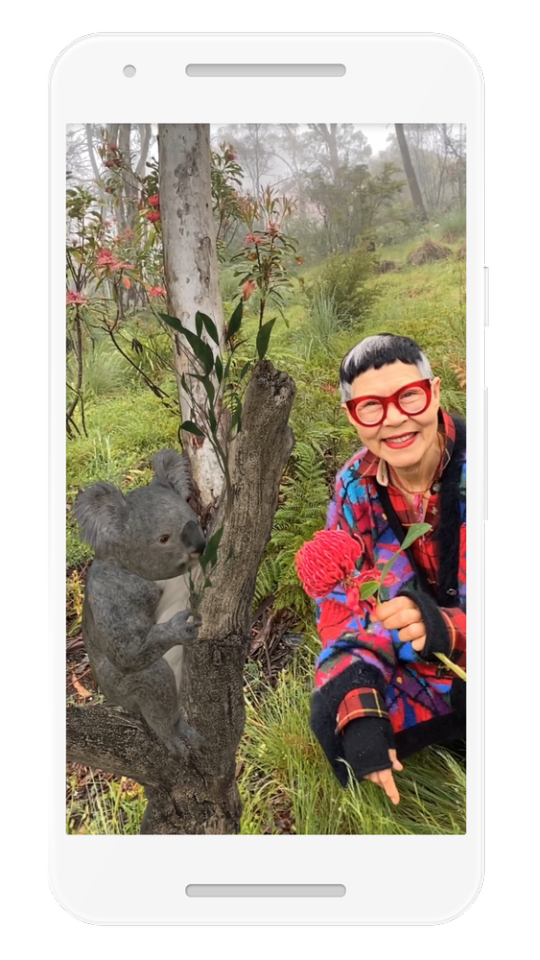
Our fascination with Aussie creatures, especially koalas, has been on the rise this year. During Australia’s devastating bushfires—which endangered thousands of koalas—search interest for koalas hit an all-time high globally in January and we even worried they may be extinct (thankfully, we can confirm they aren’t).
Here’s a list of the top worldwide trending questions this year so far for the Aussie AR animals you’ll now get to meet in Search:
Are koalas extinct 2020?
What does a baby platypus look like?
Can an emu fly?
How many koalas have died?
How big are wombats?
Are koalas friendly?
How do koalas drink water?
What does the inside of a kangaroo pouch look like?
Can koalas be pets?
How are baby kangaroos born?
While most of us can’t travel to the Aussie outback right now, you can learn about these animals from the comfort of your couch or picnic rug. Search for these Aussie AR animals on your mobile or tablet today so you can paddle with a platypus, cackle with a kookaburra and meet your new mARsupial mates!
Source : The Official Google Blog via Source information
0 notes
Text
"Understanding Africa’s $180B internet economy future"
Genetic scientists study human DNA to better understand medical conditions and how to treat diseases. But their research is often based on samples that don’t actually reflect the world’s population. Around 80 percent of the human DNA used in genetic studies is from people of European descent. This means that researchers are often unable to study and address conditions that affect global ethnicities.
In January 2019, Abasi Ene-Obong, a young tech engineer from Nigeria, founded 54gene with the aim of making gene studies more representative by increasing access to African genomic data—which currently accounts for less than 3 percent of all genetic data sets. After securing two rounds of funding, 54gene has gone on to complete a fully resourced biobank in Lagos, crucial to support academic research, drug development, and disease detection.
Ene-Obong’s story is just one example of how talented African entrepreneurs are creating new opportunities across the continent. As a new report from Google and the International Finance Corporation (IFC) shows, the startup ecosystem is helping drive Africa’s internet economy towards a projected value of $180 billion by 2025, or 5.2 percent of the continent’s GDP.
We collaborated on the report—titled ”e-Conomy Africa 2020: Africa’s $180 billion internet economy future”—to highlight the strengths and challenges of the internet economy today, and to better understand where it might go in the future. Here are some other things we learned.
Startups in Africa are progressing and reaching new milestones
According to Partech Ventures Africa, African tech startups reached a new milestone in 2019 with $2.02 billion of equity funding raised. That’s 74 percent more than in 2018, and represents an average deal size of $8.08 million.
At the forefront of the internet economy’s growth are startups in sectors like financial technology (fintech), e-commerce, health, e-logistics, e-mobility and food delivery. Fintech leads the way in terms of funding, receiving 54 percent of all African startup investment in 2019. This indicates high investor trust, which is significant given the sector’s important role serving unbanked and financially excluded Africans.
One example is the Nigerian digital payments and commerce platform Interswitch, which received $200 million in equity funding from Visa in 2019, as well an IFC investment of $10.5 million. These investments came at a time of big growth for the electronics payment market, and, as a result, Interswitch has helped transform the infrastructure of Nigeria’s banking system, while extending its services to 23 other countries.
E-commerce startups have also shown strong growth, thanks to improved digital payment services and a rise in mobile technology and payment channels. In 2019, e-commerce accounted for $134 million in funding across 30 deals--a 36 percent increase in the number of deals compared with 2018. With COVID-19-mandated lockdowns in countries across the continent, consumers have quickly gotten much more used to e-commerce, and their new online shopping behavior may well extend beyond the pandemic.

Young developer talent is shaping the future
The African developer scene boasts 700,000 professional software developers, many of them trained through university programs, others self-taught.
There’s an enormous amount of talent, but these developers need help to find jobs and take their ideas forward.
Coding classes, like those offered by Google, Decagon, Gebeya and others, are helping close knowledge and skills gaps, while professional communities continue to grow. There are more than 160 active Google Developer Groups and 200 Developer Student Clubs in Sub-Saharan Africa, offering training and support to help developers meet job requirements. And since its launch in 2018, theGoogle for Startups Accelerator Africa program has worked with 47 startups from 17 African countries—helping them develop products and build successful companies and products. One of the 2016 global accelerator graduates, Nigerian fintech startup Paystack, was recently acquired by Stripe for over $200 million.
IFC is also playing its part to advance digital skills development, making investments in regional startups and accelerators that cultivate tech talent. Gebeya—a company IFC supports in Ethiopia—has trained over 500 young software developers, most of whom are women, and is providing seed funding to 30 graduates to pursue their own digital ventures. IFC investee Flat6Labs is fostering tech entrepreneurship (and women entrepreneurs in particular) by directing early stage funding to startups in both Egypt and Tunisia.
Whether it's helping startups grow, training developers or providing tools for small businesses, both Google and IFC are committing to bringing the benefits of technology to millions more people across this extraordinary continent. We invite you to read the report and learn more about the opportunities unfolding throughout Africa’s thriving internet economy.
Source : The Official Google Blog via Source information
0 notes
Text
"Technology can help facilitate courageous conversations"
In my classroom, making connections with students was at the center of my teaching practice and became vital for student success. Educators are not monolithic. We are counselors, caregivers, social workers and student advocates. As the lines between school and home have blurred, guardians also play those roles in supporting their child with hybrid or distance learning. Teachers in school and families at home are looking for resources to communicate with their students and children about the world around them. Through the use of Google tools and apps and content from our partners, educators and families can begin to have these courageous conversations.
Google tools can help you connect with students
Use Google Forms for daily mood check-ins, Google Meetto connect one-on-one with students, or younger students can use Google Drawings or Jamboard to illustrate how they’re feeling. For lesson plans and resources, check out Be Internet Awesome for online safety, and G Suite for Education additional services like Applied Digital Skills for lessons for educators on well-being, and Blogger as a journaling tool for students to channel their emotions and communicate how they are feeling. The Google Teacher Center offers a free training module with tips to foster creative community building whether teaching in-person or remotely. Families can also head to Google's digital wellbeing page for guides and resources for managing screen time and talking about digital wellbeing, as well as social-emotional learning (SEL).
These apps can help, too
Chromebook apps like Classcraft, ClassDojo, Peppy Pals, Wisdom - Kingdom of Anger, and Headspace help students learn how to express their emotions, and apply what they’ve learned in school to their lives outside the classroom. You can find all of these apps on the Chromebook App Hub, along with great ideas on how to use apps like Adobe Spark for social-emotional learning. Additionally, Sanford Harmony has a curriculum designed to support social emotional learning to develop students into compassionate and caring adults.
Creating space to have courageous conversations
Many educators are finding it challenging to have conversations about social justice or racial inequity with students, especially while remote learning. There are many great resources out there from Google partners, including NEA EdJustice’s guide on creating space to talk about race or Tolerance.org’s empathy through critical discussion and listening are great places to start. These resources can foster understanding and support as students process complex societal issues. There are also many book recommendations and conversation guides from The Conscious Kid to help facilitate hard conversations and talks about identity.
Advice and resources from educators around the world
It’s also important for educators to lean on their community right now, as they’re impacted by these changes and are responsible for talking to their students about them. You can join a Google Educator Group, a global group of educators who share best practices and ideas. We’re also hosting Twitter chats to bring educators around the world together, including one today at 3pm PST on social-emotional learning with Dwayne Reed.
More ideas for social emotional learning
If you’re looking for more ideas for improving student SEL, visit the website forCASEL (Collaborative for Academic, Social, and Emotional Learning), which offers resources such as webinars, more on Common Sense Media's app recommendations, and Lalilo’s SEL Lessons and Activities for Distance Learning. You can watch our webinar on SEL, and visit Teach from Anywhere, Google’s hub of information and tools to help teachers during COVID-19.
Source : The Official Google Blog via Source information
0 notes
Text
"A wave of change for Southeast Asia’s internet economy"
Over the past five years, Southeast Asia’s internet economy has experienced tremendous growth and change. But what we’ve seen in 2020 marks the biggest shift yet, as the e-Conomy SEA 2020 report from Google, Temasek and Bain & Company shows.
The report—At Full Velocity: Resilient and Racing Ahead—outlines how Southeast Asians navigating the coronavirus pandemic are using the internet in more ways and on a larger scale than ever before.
Since the beginning of the year, 40 million people in Southeast Asia have connected to the internet for the first time (compared to 10 million in 2019 and 100 million between 2015 and 2019). With technology providing vital access to online shopping, food, healthcare, education, finance and entertainment, more than one in every three digital service consumers started using a new type of online service due to COVID-19. And of those new digital consumers, nine out of 10 plan to keep using at least one digital service beyond the pandemic.

10:25
Despite a global economic slowdown, and the severe impact on travel in particular, the gross merchandise value of the regional internet economy has held steady at an estimated $100 billion in 2020, and is expected to surpass $300 billion by 2025.
Technology’s vital role during the crisis
Eight out of ten people across the region said technology helped them get through the virus—and they used the internet for a wide range of reasons. In most of the sectors we looked at, new users made up more than 30 percent of total, but education, groceries and loans saw the biggest jumps.

The pandemic also saw demand for (and access to) digital services continue to expand beyond Southeast Asia’s biggest cities. In Indonesia, Malaysia and the Philippines, more than half the people new to digital services live in non-metropolitan areas. This is encouraging progress, given that the urban-rural digital divide is one of the main challenges the report has highlighted over recent years.
The changing shape of the regional internet economy
Not surprisingly, e-commerce is growing faster than we could have imagined before the crisis: from $38 billion in value last year to $62 billion this year, and expected to reach $172 billion by 2025. Digital financial services are becoming more important, too: the average proportion of cash transactions declined from 48 percent of the total pre-COVID to 37 percent post-COVID. From here, the report finds that the annual value of total digital payment transactions across Southeast Asia will almost double to $1.2 trillion by 2025.

At the same time, new sectors are emerging, especially in education and health technology.
At the peak of the pandemic, leading health apps were being used four times as much as they were before the pandemic and education technology app installations had increased three-fold.
Greater focus for businesses, cautious optimism for investors
Global uncertainty means Southeast Asia’s major technology companies are focusing on strengthening their business and becoming profitable, rather than on expanding into new areas. Funding for companies valued at more than $1 billion has dropped from $5.6 billion in 2019 to an estimated $3.5 billion in 2020.
Overall, investors are cautiously optimistic. The number of deals has kept growing and we’re starting to see investors look towards new areas of opportunity in financial services, education and healthcare. For startups with strong ideas and business plans, there’s an available pool of capital worth almost $12 billion.

Building for the opportunity ahead
COVID-19 has changed Southeast Asians’ daily lives in fundamental ways. The digital adoption that was projected to happen over several years has accelerated. And with its young, diverse and mobile-first population, and a host of talented start-ups, Southeast Asia can help shape the future of technology in Asia-Pacific and beyond.
Like everywhere else in the world, Southeast Asia faces significant challenges in rebuilding from the pandemic—but there is such immense opportunity if we can help the region realise its potential. Working with our partners across the region, all of us at Google are committed to playing our part— fostering startups, expanding digital skills, and making the internet more helpful and accessible in every way we can. We’re ready to help build a strong, diverse and inclusive internet economy for every Southeast Asian.
Source : The Official Google Blog via Source information
0 notes
Text
"Meet the Googlers breaking down language barriers for migrants"
Googler Ariel Koren was at the U.S.-Mexico border in 2018 when more than 7,000 people from Central America were arriving in the area. Ariel, who speaks nine languages, was there serving as an interpreter for asylum seekers fighting their cases.
Ariel, who leads Marketing for Google for Education in Latin America, knew language skills would continue to be an essential resource for migrants and refugees. She decided to team up with fellow Googler Fernanda Montes de Oca, who is also multilingual and speaks four languages. “We knew that our language skills are only valuable to the extent that we are using them actively to mobilize for others, ” says Fernanda. The two began working to create a network of volunteer translators, which they eventually called Respond Crisis Translation.
In addition to her job leading Google for Education Ecosystems in Google Mexico, Fernanda is responsible for recruiting and training Respond’s volunteer translators. Originally, the group saw an average of five new volunteers sign up each week; now, they sometimes receive more than 20 applications a day. Fernanda thinks the increased time at home may be driving the numbers. “Many of them are looking to do something that can have a social impact while they're staying at home,” she says. Today, Respond consists of about 1,400 volunteers and offers services in 53 languages.
Fernanda says she looks for people who are passionate about the cause, have experience in legal translations and have a commitment to building out a strong emotional support network. “Volunteers have to fight against family separation and support folks who have experienced disparate types of violence and abuse,” she says. “It’s also important to have a support network and be able to take care of yourself.” Volunteers have access to a therapist should they need it.
In January 2020, the group officially became an NGO and to date, Respond Crisis Translation has worked on about 1,600 cases, some of which have helped asylum seekers to win their cases. Respond Crisis Translation largely works on cases at the Mexico-U.S. border, but is also increasingly lending their efforts in Southern Mexico and Europe. The COVID-19 pandemic also prompted the group to explore more ways to help. Volunteers have created translated medical resources, supported domestic violence hotlines and have translated educational materials for migrant parents who are now helping their children with distance learning.
One challenge for the team is meeting increasing demand. “We weren’t just concerned about growing, but ensuring the quality of our work as we grew,” says Ariel. “Small language details like a typo or misspelled word are frequently used to disqualify an entire asylum case. The quality of our translation work is very important because it can impact whether a case is won or lost, which can literally mean the difference between life and death or a deportation. Every time there’s a story about someone who won their case we feel a sense of relief. That’s what motivates us to keep going.”
Ariel and Fernanda also hope Respond Crisis Translation can become an income source for indigenous language translators. Whenever they work with indigenous language speakers, Respond asks the NGO they’re working with to provide compensation to the translator for their labor.
Although Ariel and Fernanda didn’t expect their project to grow as quickly as it has, they’re thrilled to see the progress they’ve made. “Being a multilingual person is a very important part of my identity, so when I see that language is being used as a tool to systematically limit the fundamental right to freedom of mobility,” says Ariel. “I feel a responsibility to resist, and work alongside the language community to find solutions.”
Source : The Official Google Blog via Source information
0 notes
Text
"La Fédération Française des Associations de Commerçants (FFAC) annonce la création de ‘Ma vitrine en ligne’, un service numérique dédié aux commerces de proximité avec Google France"
La FFAC, qui représente les 6000 unions commerciales réparties sur le territoire français (France métropolitaine et Outre-mer), annonce, en partenariat avec Google France, la mise à disposition d’experts numériques afin d’accompagner les commerces indépendants et les artisans et assurer la continuité de leur activité en ligne.
Dans un contexte de crise sanitaire et économique, ce service dédié aura pour double objectif d’améliorer la visibilité des commerces en ligne, et d’aider ces commerces à développer la vente en ligne. Seulement 32% des très petites entreprises françaises possèdent un site Web aujourd’hui.
Face à l’urgence économique et dans le cadre de l’appel à mobilisation lancé par le Gouvernement, la FFAC et Google France ont décidé d’unir leurs expériences afin de répondre rapidement aux défis auxquels font face les commerçants de proximité. Comment mettre le numérique à portée des commerçants et des artisans dans un contexte de crise? Ce sont les compétences techniques, et l’expérience d’accompagnement des équipes de Google France qui permettront de proposer des solutions et des outils adaptés aux besoins des commerçants de la FFAC à travers les territoires.

Un nouveau service d'accompagnement dédié par téléphone
Ainsi, dès le 9 Novembre, un service dédié d’experts du numérique sera mobilisé afin d’aider les commerçants à améliorer leur visibilité et développer la vente en ligne. La FFAC et Google France ont ainsi co-construit un parcours d’accompagnement adapté aux besoins des commerçants et des artisans, comprenant:
Un coaching personnalisé: Une équipe de spécialistes du numérique établiront un diagnostic personnalisé et guideront les commerçants 6 jours sur 7, de 8h à 20h, par téléphone ( 01 76 21 52 00 ) ou visioconférence.
Des outils gratuits: Un ensemble d’outils de visibilité en ligne mis à disposition par la FFAC et Google.
Des formations au numérique: Un programme de formations interactives adapté aux besoins des commerçants et des acteurs chargés d’accompagner les commerçants sur le terrain, afin de simplifier la prise en main des outils du numérique.
Concrètement, les commerçants pourront prendre contact avec des experts, afin de mettre en place rapidement leur profil d’établissement sur le moteur de recherche, et proposer de nouveaux services e-commerce à destination de leur clientèle, comme le click & collect.
“La crise sanitaire que nous connaissons aujourd’hui a démontré plus que jamais la nécessité pour nos commerçants d’être présents sur le Web. Avec ce programme ambitieux soutenu activement par Google, la Fédération Française des Associations de Commerçants souhaite accompagner le plus grand nombre de commerçants et d’artisans français dans leur nécessaire démarche de digitalisation et leur stratégie omnicanale.” Jean-Claude Delorme, Président de la FFAC
“Il est important d’unir nos forces dans la situation actuelle afin de soutenir les commerçants. Nous sommes ravis de mettre à disposition de la Fédération Française des Associations de Commerçants tout notre savoir-faire et notre expérience, afin de faciliter la digitalisation des artisans et commerçants de proximité.” Sébastien Missoffe, Directeur Général de Google France
Ce service dédié “Ma vitrine en ligne” sera accessible sur le site g.co/ma-vitrine-en-ligne. Un guide pratique détaillant en 6 étapes simples “comment développer ma présence en ligne” sera également mis à disposition des commerçants.
Source : Le blog officiel de Google France via Source information
0 notes
Text
"New in Web Stories: Discover, WordPress and quizzes"
Things are moving fast around Web Stories. To keep you in the loop, we’ll be rounding up the latest news every month. You’ll find new product integration and tooling updates, examples of great stories in the wild and educational content around Web Stories.
Web Stories arrive in Google Discover

Last month we announced that Web Stories are now available in Discover, part of the Google app on Android and iOS that’s used by more than 800 million people each month. The Stories carousel, now available in the United States, India and Brazil at the top of Discover, helps you find some of the best visual content from around the web. In the future, we intend to expand Web Stories in Discover to more countries and Google products.
New tools for the WordPress ecosystem

There are more and more ways to create Web Stories, and now WordPress users now have access to not just one but two visual story editors that are integrated into the WordPress CMS: Google’s Web Stories for WordPress and MakeStories for WordPress.
MakeStories also gained six new languages (English, German, French, Italian, Portugese and Russian), and has new features including new templates and preset rulers. They’ve also made it easier to publish your Web Stories with a new publishing flow that highlights critical pieces like metadata, analytics and ads setup. You can also now host stories on MakeStories.com, but serve them off your own publisher domain.

MakeStories new publishing workflow in action in WordPress.
There are many different options out there to build Web Stories, so pick the one that works best for you from amp.dev’s Tools section.
Quizzes and polls are coming to Web Stories
We’ll also be covering Web Story format updates by the Stories team here as they’re at the forefront of innovation of Web Stories: you can expect the features they bring to Stories to appear in the visual editor of your choice sometime after.

Web Stories are getting more interactive with quizzes and polls, or what the Stories team call Interactive Components. These features are currently available in the format, and you can learn more about them in developer documentation. Several visual editors are working on supporting these new features so you can use them without any coding necessary on your end.
Learn how to create beautiful Web Stories with Storytime
One of the best ways to learn the in’s and out’s of Web Story-telling is our educational Storytime series, with a new episode arriving every week. If you haven’t yet started watching, we encourage you to give it a try.
In October, we interviewed the Product Manager behind the Google Discover integration; talked about the art of writing, remixing, optimizing and promoting Stories; analyzed the fabric of a great Web Story; and covered all sorts of editorial patterns that work for Web Stories.
And you can check out all of these videos as Web Stories:
editorial.jpg
Our editorial patterns for Web Stories overview.
2.jpg
Learn about the fabric of a great story.
discover.jpg
Web Stories now available in Discover.
5 inspiring new Web Stories
We wanted to highlight some of the amazing work from our creator community this month: Pinch of Yum’s story on broccoli cheesesoup was mouth-watering, and we learned so much from USA Today’s FAQ on gold. On Input Mag, we saw an artist turn gadgets into pixel art, and NDTV showed us how to make keto chicken momos. And right in time for Halloween, there’s Den of Geek’s roundup of Amazon Prime horror movies.
Pinch of Yum
Pinch of Yum’s story on broccoli cheese
Gold
USA Today's 'Importance of Gold'
Den of Geek
Den of Geek's '7 Must-See Horror Movies'
Pixel art
Input Mag's story on pixel art.
Momos
NDTV's How to Make Keto Chicken Momos
We’ll be back next month with more updates. Until then, let us know if you made a cool story you think we should feature. Tell us about it on Twitter or Instagram.
Source : The Official Google Blog via Source information
0 notes
Text
"Halodoc uses AI to improve how doctors receive feedback"
Due to Indonesia’s vast size and population, timely and reliable access to healthcare can sometimes be a challenge. Halodoc aims to change that with a mobile first-telemedicine platform that connects Indonesians to doctors and helps them arrange appointments, medicine deliveries and tests.
What’s distinctive about the Halodoc platform is that it draws on human-centered artificial intelligence: a promising new area of research that uses continuous human feedback to improve how AI systems work, and provides a better experience for the people who rely on those systems.
With support from Google’s Late Stage Accelerator, a program that assists high-potential startups, we assembled a team of doctors, data scientists, engineers, product managers and researchers to determine how technology could support Indonesian doctors’ work. One particular approach the team identified was using AI to replicate the mentoring and feedback that junior doctors receive from more experienced colleagues in hospitals—a process that’s important to improving quality of care, but is hard to reproduce on a larger scale.
We set out to create an easy way to provide feedback in virtual health, and worked with Google’s machine learning experts in the Late-Stage Accelerator to determine the best approach. With Google’s guidance, Halodoc's engineers applied Natural Language Processing in Bahasa Indonesia to measure, rank, and provide insights that can inform doctors’ decisions across the country—using thousands of consultations to train their machine learning models.
When doctors open the Halodoc app, they see information on how they performed based on their response time and quality index metrics, along with suggested actions on how they can improve their consultation quality. They also have the option of receiving further feedback and coaching from more senior doctors if needed.
Right now, more than five percent of Indonesians use Halodoc’s platform. As a result of applying AI principles to improve the quality of care that patients experience, our app ratings have increased from 4.5 to 4.8 stars in fewer than six months, while our overall doctor scores have improved by 64 percent.

Halodoc’s telemedicine app enables doctors to deliver personalized feedback with assistance from ML-enabled insights that improve patient care.
From here, with Google’s help, we hope to continue simplifying Indonesia’s healthcare infrastructure and advance the application of AI in healthcare globally.
Source : The Official Google Blog via Source information
0 notes